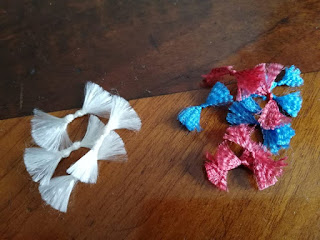I made a victorian summer daydress for a friend early this year and bought all they had of this striped fabric with the intention of a) getting a better price, and b) making another dress for myself. The striped cotton would look lovely as a Francaise, the pleats would drape nicely, but on the other hand I'd love to drape the skirt into a polonaise style which to me looks weird with paniers and Watteau pleats and thus requires an Anglaise.
The answer to the dilemma: a robe à la Piemontaise, which combines the advantages of a Francaise (the Watteau pleats) with those of an Anglaise (can be draped into a faux Polonaise). Plus I've seen period pictures of draped Piemontaises but not a single draped Francaise.
There are excellent tutorials on Koshka's website, as well as on Isis' website. My version is to be worn over paniers with a violet underskirt, or draped Polonaise-style with a different underskirt over a bumroll. Two different skirts because for paniers, the sides of the skirt have to be longer to make for an even hemline when worn. If you loop up the gown it doesn't matter if it's actually cut to fit over paniers.
And I still have enough fabric left to make a victorian bustle gown...
----------
The cut of the slightly boned bodice follows a Francaise pattern from Norah Waugh's "The Cut of Women's Clothes", as does the petal-shape edge of the engageants. I cut them with the same pinking-edge-scissor-trick I used for the flounce of my striped skirt, deto the ruffle that decorates the front edge of the robe. The lace beneath the engageants is machine-embroidered cotton lace, matching the colour chart for this dress. It's good quality, so the embroidery doesn't look machine-made on first and second sight.
The stomacher consists of one layer of buckram with five lengths of boning sewn on, then covered with top fabric and lining which is closed at the top back. It's the same fabric as the Francaise petticoat and imitates the ribbon closing very common in pictures of Mme de Pompadour but is completely detachable, the ribbons look as if they were closing the robe but are merely decoration.
 |
| Unadorned stomacher |
 |
| Decorated version |
 |
| Ribbon with lace on top... |
 |
| ...topped off with satin ribbon |
The ribbons were sewn to the edge, then tied into bows and fixated to the stomacher with a few invisible stitches as they're not meant to open. The edge trimming consists of two rows of pre-pleated ribbon zig-zagged together, two rows of lace sewn on top and a length of slender ribbon, slightly curled, stitched on top to cover up any machine seams. I also made some silk flies in violet and cream that I have to put somewhere...
The complete front edge of the robe is decorated with a self-fabric ruffle (take care to cut striped fabric across so you get horizontal stripes) and the same decoration in its centre as on the stomacher - pleated ribbon, lace, curled satin ribbon.
The petticoat for wearing the robe Francaise-style is decorated with a ruffled strip of self-fabric along the hemline and a length of pleated ribbon (I thought I had bought ten metres but it seems it was one of those occasions when I say "oh, you know, I'll take the whole package".)
Assembling the back part of a Piemontaise is a bit tricky. Attach both side parts of the skirt to the bodice. Then attach to the skirt the centre back part that's to be pleated. Mark where it meets the lowest edge of the bodice and sew the part above this into a tube. At the lower end of it make a T-cut that goes edge to edge with the bodice, the rest above is pleated and sewn to the neckline. Those pleats should fall freely but not slacken around where skirt and bodice meet. All I can say is that I love my tailor's dummy!
A not very good shot of the beta-version I wore to the last rococo ball, taking pictures inside was forbidden unless you were the official photographer. Actually this dress wouldn't be a ballgown but rather a nice summer dress - but considering that figuring out the pattern took ten times longer than planned and thus time was short (again) it was good enough.









































